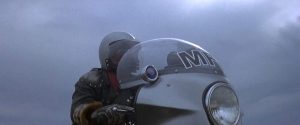THE only true Australian cult cinema classic is George Miller’s Mad Max.
This road revenge action movie was released four decades ago.
It cost just $400,000 and was initially slow to impress critics and audiences in 1979 who were more akin to watching and praising the likes of Picnic at Hanging Rock or Newsfront.
Locally-made genre films were generally considered to be cheap and nasty pleasers of a certain, non-discerning crowd.
Slowly (pre-internet), through mainly overseas-generated word of mouth, the film grew in stature, going on to earn more than $100 million, spawn three successful sequels and countless imitators.
Lead actor Mel Gibson became an international star and creator George Miller a much sought-after director.
On one level Mad Max isn’t a great movie; the story is basic in the extreme and the continuity is frankly all over the place most of the time.
Miller, who is also a medical doctor, has oft-stated that the film was inspired by his experiences helping deal with road trauma.
But the end result is not a clear reflection of this perspective, perhaps due to limited budget and time factors that rushed the film into production and onto distribution and impacted Miller’s ability to translate a clear vision to the screen.
Or, as a first-time screen writer and director, maybe he just struggled in that regard.
Either way, rather than condemning the national obsession with killing ourselves through reckless road use, Mad Max was seen by many as celebrating the violent merger of man and machine.
It’s fair criticism, but can be separated from the power and impact of what is still an amazing cinematic achievement.
Mad Max starts in a way that suggests it’s in a hurry to get to the finish.
It’s ‘a few years from now’ and a maniacal driver calling himself The Nightrider and his equally-amped girlfriend are in a high-speed chase with the police highway patrol.
Two pursuit cars and a motorbike can’t keep up. It’s left to Officer Max Rockatansky in his Interceptor to bring things to a head, which he does with steel nerve and ruthless precision.
The tone is set by Miller and his cinematographer David Eggby from the first moments, the camera right alongside, behind or in front of the vehciles as they thunder through a series of spectacular stunts made all the more impressive by the fact much of the filming was initially done without official permissions.
As Max’s boss tells him, they are the last of the true heroes keeping law and order in a crumbling, decadent society. They are the only things standing between man and the animals, represented by the bikie gang led by the enigmatic Toecutter.
But Max has seen and had enough and, after his partner dies in horrific circumstances, he takes leave with his wife Jessie and infant son Sprog.
Chaos follows and Max is forced into a final, violent hunt for retribution and confrontation on the highway battlefield using his hyper-charged ‘last of the V8s’ as the ultimate weapon.
The film is not only exciting and visceral, it’s also, like Max himself, just a little bit crazy.
The retro car designs are stunning, the Halls of Justice location effectively simple, the costuming constantly eye-catching and Brian May’s music…well, it should have never worked, but actually does.
Roger Ward, as Max’s giant leather-clad, cigar-chomping boss Fifi, and Steve Bisley as Max’s wise-cracking, reckless partner Goose, are a lot of fun, while Hugh Keays-Byrne’s quietly insane Toecutter is truly a unique character in the annals of cinema villains. Think Health Ledger’s Joker as a modern version.
It ain’t a perfect genre film, but damn it’s close.
